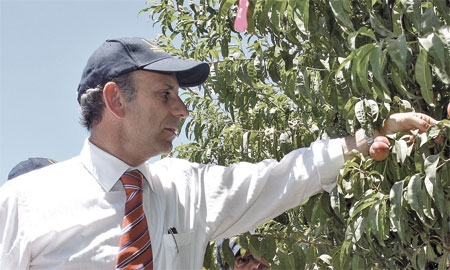With strong support from Minister of Agriculture Jose Antonio Galilea, Chile’s leading agro-businesses are enjoying a period of rapid expansion, positioning themselves on the global stage.
Chile’s Agrosuper is now one of the world’s largest pork producers and also boasts sizeable poultry exports. Agricultural giant Olave – which produces the Best Organic Olive Oil in the world, according to Italy’s Biol competition – is also one of the country’s largest grape producers, and has conquered a range of international markets, including the U.S., Canada, Japan, Mexico, Brazil, Venezuela, Guatemala and Colombia. In addition, producer
David Del Curto currently exports US$160 million of fruit per year to the U.S., Canada, Europe, Middle East and Asia.
David Del Curto’s executive director, Julio Fernandez, explains how the company pioneered the growth of Chile’s fruit exports: “We started exporting onions, garlic and legumes in the 1960s. In the 1970s, the government began to promote exports, but there was a problem with the preservation of the fruit being exported, since Chile is quite far from the main markets. In this sense, David del Curto, the company’s founder, was really a pioneer. He began to question the products that were being exported, and from then on, Chile began to export more particular products, such as grapes.
“Today, more than 85% of the grapes that are consumed in the U.S. are Chilean. Later, we began to export other products such as kiwis and cherries. The first sector to experience a boom in Chile was the fruit sector. Later, it was wine and today it is salmon.”
Dairy products cooperative
Colun is Chile’s largest producer of cheese, and a major producer of milk products and butter – one of the country’s promising new industries. It currently exports to countries throughout the region, as well as to the U.S., Japan, Russia, China and Korea.
Colun president Augusto Grob agrees that the agricultural industry’s success is due to “the willingness of Chilean companies to innovate, to develop non-traditional products, and definitely to position the industry on the global market,” as well as to “strong government support.”
Mr. Grob also believes that attention to quality has been a significant contributor. “For us, having a food product of indisputable quality is essential. To achieve this, new technologies must be applied throughout the production process, so we are continually replacing equipment and modernizing our facilities,” he says.
An example of value-added export growth is Chile’s wine industry, which now boasts more than 300 vineyards that have positioned the country as the world’s fifth largest wine exporter (between 1995 and 2007, exports increased by 373%), and 10th largest producer. The country’s flagship company, Concha y Toro Vineyards, Latin America’s leading wine producer and exporter and one of the world’s top 10 wine companies, has a presence in over 135 countries.
Embotelladora Andina (Andina Bottling Company) is another example of the entrepreneurial spirit of Chile’s agro-industry. A Coca-Cola franchise, the company now manufactures, bottles and distributes more than 8 million liters of carbonated beverages per day to hundreds of thousands of outlets in Chile, Brazil and Argentina. Through subsidiary Rio de Janeiro Refreshments, the company produces both alcoholic and non-alcoholic drinks, mineral water, juices, syrups and energy drinks in Brazil.
Listed on the Chilean and New York stock exchanges, Embotelladora Andina boasts more than a 60% share of the markets in which it operates. Executive vice-president Jaime Garcia says that the willingness of Chile’s business community to take calculated risks and to expand globally has driven growth in the agro-industry.
“About 17 years ago, Andina saw that there were opportunities in the world, and a certain restlessness to develop and expand was born. So we entered Brazil and Argentina, and started looking for new options to grow because our domestic market is small. In the future, we also want to enter new markets. There are always new opportunities in the world, and it is important for us to be prepared to take advantage of them. Consequently, one of the factors in our success has been the vision and the quality of our business leaders,” Mr. Garcia says.
Finally, no discussion of Chile’s agro-industry would be complete without mention of its fishing sector, and in particular, its aquaculture industry, which produced over 300,000 tons of fish last year. Indeed, Chile is today the world’s second-largest producer of farmed salmon after Norway (bringing in revenues of US$2.1 billion in 2009), a testament to the remarkable growth the sector has enjoyed over the past two decades.

0 COMMENTS